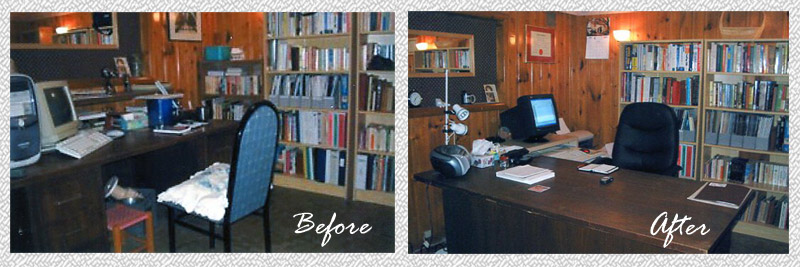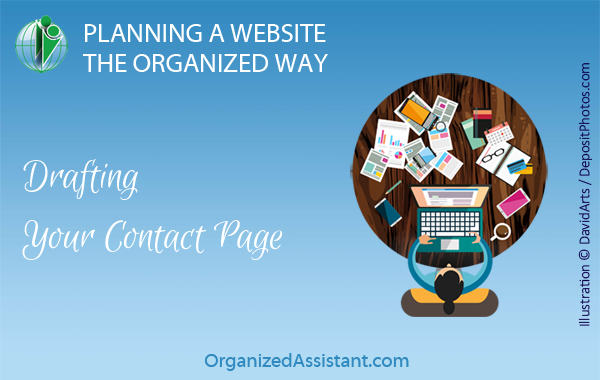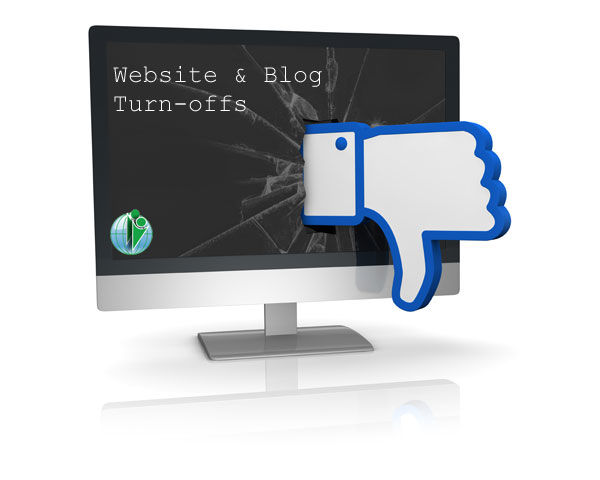Before and After Photos: Yea or Nay?
This page may contain links to Amazon.com or other sites from which I may receive commission on purchases you make after clicking on such links. Read my full Disclosure Policy

It’s frequently recommended that you display samples of your work on your website in the form of before and after photos, because of the powerful impact they can have on potential clients. Yet, only about half of the professional organizers I work with have before and after pictures on their sites. Why do you think that is?
One of the organizers who chooses not to display before and after photos is Porter Knight. Here’s what Porter tells people who ask her, “Where are the before and after pictures?”

Occasionally, in my 14 years as a Professional Organizer, folks have asked to see “before and after” pictures of my work with clients. A visual image is powerful, but that is precisely why I don’t show them. Though I have had dozens of clients give me permission to take and share photos over the years, there are three reasons why I don’t use them to illustrate the transformation people experience when we work together.
1. Organizing is about you.
It is personal and subjective. If you can’t find what you need when you need it or you aren’t accomplishing your goals, you’re likely not feeling very productive, regardless of what it looks like. If you want things to be different, I can teach you a way. I’ll meet you where you are and take you where you’re ready to go. Whether you are functioning at a very productive level and want to streamline your systems to achieve even greater output, or whether you have created piles so deep in your office that you have to work in another room — if you want to create change, my methodologies will help. But looking at someone else’s “before” photo might give you the wrong impression – either that you are too far gone for help, or that because you aren’t so far gone you can’t benefit from additional training. Other people’s pictures aren’t relevant – organizing is about you: where you are and what you want to achieve.
2. Organizing skills are tools you use as part of an ongoing process.
And that process is a means to an end, not an end unto itself. We don’t organize for the sake of organizing. We organize to improve productivity in pursuit of a greater goal. You start by identifying what it is that you want, what you really want to accomplish. Then we design systems to help you get there. But once the systems are in place, you still have work to do. Before and after pictures imply that there is a “before” and an “after.” But really, there is only “during.” A picture taken after sessions dedicated to improving productivity doesn’t show an “end” point, just a point. It’s an on-going process.
3. The internal transformation is more important than the external appearances.
Fundamentally, getting organized is about improving your decision-making capacity and exercising discipline to actually make decisions. A picture doesn’t capture this internal learning. A picture only shows how things look, but an “after” picture doesn’t give you insight into a client’s improvement. What matters is that the client experiences a break-through in his or her own ability to make decisions and be productive in pursuit of his or her goals.
Finally, I must make a point about neatness. “Neat” and “organized” are not synonymous, though neat can often be a product of the organizing process for two reasons: First, deliberate decision-making results in less being kept in the first place – you won’t be keeping things you don’t need (less stuff = neater environment). Second, creating a system for accessing those things you do need results in things being more clearly grouped and contained (named homes for things = neater environment). But while a neater appearance is a common product of the organizing process, rarely is it the sole or even primary goal. The goal of organizing is to be able to find what you need when you need it so you can accomplish what you set out to accomplish. Improved decision-making is the key. An “after” picture doesn’t capture this internal transformation.
I know we all derive voyeuristic pleasure from seeing pictures of other people’s challenges, so I’m sorry to deprive you of that! But now you know more about organizing, and you wouldn’t have learned that by looking at pictures.
We can learn from each other’s experiences, however, and that’s why I include an hour long DVD with my book Organized to Last: 5 Simple Steps to Staying Organized. The beauty of the DVD is that you see real people working through the decision-making process. You see their struggle and transformation as the concepts click into place for them. The DVD ends not with perfectly decorated spaces, but with spaces and systems that are on the way to achieving just what the clients needed. And you hear their triumph: they discuss how they learned the skills that will now last them a lifetime, allowing them to pursue their dreams and maintain a more centered lifestyle. This, then, is the true benefit of getting organized. Just picture it!
What are your thoughts on this subject? Do you show before and after pictures on your website or blog, or in your printed marketing materials? Why or why not?




I don’t have before & after pictures on my website either. For one thing, I’m a pretty lousy photographer so my photos certainly wouldn’t ADD anything to my site.
I do use before and after pictures in my presentations and one-on-one sessions with my clients. The reason I do is mostly to show how a product can be used more effectively to organize a space; for example shelf extenders in a cupboard or mini-baskets in a drawer.
Also, when I’m using these pictures as part of a seminar, it gives me the chance to explain WHY I’ve done what I’ve done – how it improves the client’s life – not just making it look pretty.
Jacki – Your strategy of only using photos when you’re speaking to clients, either one-on-one or in a group, could be applied online by including some descriptive text rather than just “before” and “after.” You make an excellent point though – there’s not much point in posting photos that don’t showcase your work effectively!
Janet – I’ve seen the idea of “Success Stories” on websites before and I’ve liked the idea. If you’ve got some good photos it would certainly be worth it. If you couldn’t afford (or didn’t know how) to add an extra page to your website, you could create a downloadable document with the “Success Story” on it.
Fascinating. The idea that before and after photos represent a stage in an internal process especially. It explains why “getting organized” is sometimes a short-term fix. Sometimes a person has internal stuff to sort out as well as external. A PO can help with one, but not the other.
That’s right, Kathy, because the “after” pictures really aren’t the end point at all, just the completion of that particular organizing project. What a PO can do is help the client establish new habits and routines to prevent the clutter from coming back. Although they’re not usually equipped to help the client deal with any underlying psychological issues, they need to be able to recognize when such conditions exist, and to connect them with qualified professionals when appropriate.
I certainly appreciate and agree with Porter’s views on the organizing process. However, I think that before/after pictures are helpful on many levels. For starters, many clients think that they are the only one with a disorganized space and seeing that others are in the same boat often helps to normalize their situation. Seeing that those same people found a way out also gives hope.
I think most people are aware that individual results will vary depending on their own level of participation and that organizing is not a one time event but an ongoing process. Even so, when you are mired in mess it is hopeful to see that it doesn’t always have to be that way. I also let my clients have their before/after pics so that they can remember how it was and are inspired to keep things the way they want them to be.
Joan, thanks so much for sharing your reasons in favor of showing before & after shots!
I love the idea of giving the pictures to the client as motivation to stay organized – like people who keep photos of themselves before weight loss on hand to keep them from overeating.